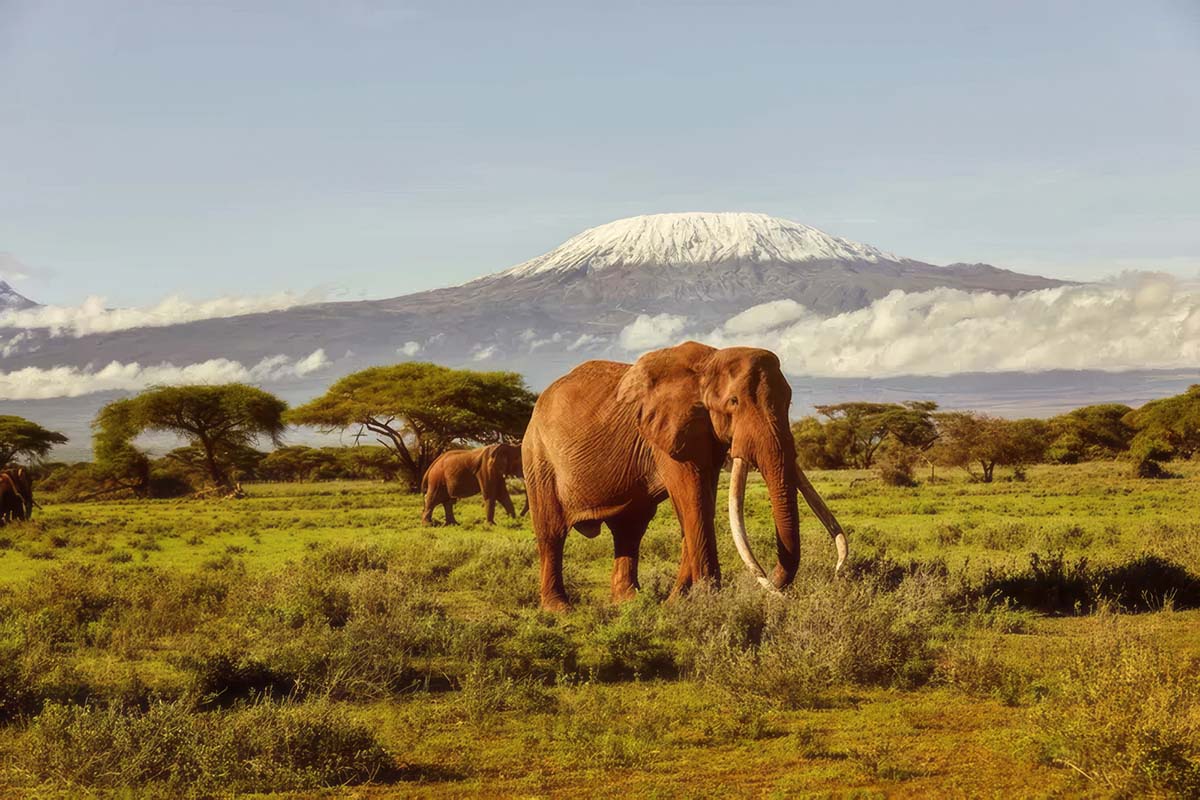 The elephant known as Craig, seen in front of Mount Kilimanjaro, walks through southern Kenya's Kimana Sanctuary. PHOTO: EMLI BENDIXEN
The elephant known as Craig, seen in front of Mount Kilimanjaro, walks through southern Kenya's Kimana Sanctuary. PHOTO: EMLI BENDIXEN
By Paul Brady
The most popular guy in all of southern Kenya has to be a 51-year-old named Craig. “Did you see Craig?” somebody will ask. And when you reply “not yet,” the news will be met with a disappointed shake of the head. He comes up at breakfast; he’s the subject of discussion at lunch. Over sunset cocktails, as the campfire gets crackling, you might hear the question: “What are the odds of seeing Craig tomorrow?”
One day, I was traveling in Amboseli National Park with Emli Bendixen, who photographed this story, and a group of safari-industry insiders, when we all had to shelter from a pop-up thunderstorm in a cement building next to an airstrip. Then a text message came through to my guide, Johnson Salaash. “Charlie Romeo,” code for Craig, had been spotted. A buzz ran through the bunker.
Somebody had tipped us off to the whereabouts of what might just be the most famous elephant in Africa: a “super tusker,” as these rare animals are known, thanks to their oversize ivories that seem to scrape the earth. Over the decades, Craig has become a highly sought-after photographic prize. Turns out, he’s devilishly difficult to spot — which is surprising, considering his body is the size of the Land Cruiser we were traveling in.
 From left: Cheetah spotting in the Maasai Mara near Angama Mara; safari guide Johnson Salaash on a game drive near Angama Amboseli. PHOTO: EMLI BENDIXEN
From left: Cheetah spotting in the Maasai Mara near Angama Mara; safari guide Johnson Salaash on a game drive near Angama Amboseli. PHOTO: EMLI BENDIXEN
But after days of searching, we finally had some intel about his whereabouts — if not an exact set of coordinates. So as soon as the rain cleared, we got back in our vehicle and headed for a private conservancy east of the national park in search of “the big boy,” as Salaash called him. That afternoon we saw cheetahs, buffalo, hyenas, and innumerable birds, but Craig remained elusive. As the sun dipped low, we agreed to head back to camp — and to rise early the next morning to resume our search.
The thing is, I was never really an elephant guy. Of course I can marvel at their majesty, and I found Salaash’s enthusiasm for the creatures infectious. But when it comes to wildlife spotting, I’m slowly turning into my bird-watching parents. I’ve got an ear for woodpeckers bashing away at branches, and an eye for finding eagles perched on snags. At my safari lodge, Angama Amboseli, I would have a bonanza of bird sightings before even setting out on a drive. Sitting in a parked Land Cruiser in Angama’s driveway, I ticked species off as fast as I could lift my binoculars. One morning, I marveled at a lilac-breasted roller, Kenya’s colorful national bird, which zipped past like a flying neon sign. Black-headed lapwings shimmied through puddles on the side of the gravel track. In the distance, past the thorny boughs of acacia trees, two gray crowned cranes stood, scanning the landscape.
Three years in the making, Amboseli has just 10 suites, yet it represents a significant milestone for Angama, the beloved high-end lodge operator. Opened in November 2023, it’s the second lodge from the brand that created Angama Mara, which is seen as one of the continent’s most luxurious safari experiences.
 From left: Dennis Adikinyi at work in the shamba, or kitchen garden, at Angama Mara; a picnic lunch in Amboseli National Park. PHOTO: EMLI BENDIXEN
From left: Dennis Adikinyi at work in the shamba, or kitchen garden, at Angama Mara; a picnic lunch in Amboseli National Park. PHOTO: EMLI BENDIXEN
Located in the Maasai Mara, the famed wildlife area in southwestern Kenya, Angama Mara opened a decade ago and immediately raised the bar for safari tourism. The property was the vision of Nicky and Steve Fitzgerald, a South African couple who worked for decades at andBeyond, the wildlife tourism company, along with their cofounder Steve Mitchell. The lodge is situated nearly 1,000 feet above the plains, on an escarpment made famous by the film "Out of Africa." Delivering high-minded design, elevated food, thoughtfully selected wine, and resort-style amenities, it represented an evolution from the canvas-clad world of traditional bush camps.
Given that history, Angama’s choice to open a new outpost in the Kimana Sanctuary, a 5,700-acre tract wedged between Nairobi and Mombasa at the foot of Mount Kilimanjaro, came as something of a surprise. Though it’s situated near Amboseli, Chyulu Hills, and Tsavo West National Parks, the area lacks the name recognition of the Maasai Mara. But Mitchell, who took over as CEO in 2022, is confident the region is on the rise.
“I really love this ecosystem,” Mitchell told me one afternoon as a rain shower rolled through and drubbed the canvas roof of the new lodge. “Our guests want to come and visit these places and connect with these people — but they’re not prepared to do that if their comfort is compromised.” He hinted that another Angama property was already in the works elsewhere in East Africa, as well as an e-commerce site that will offer curated fashions and crafts from Kenya. “This business model is at the confluence of many great things, including professional growth for Kenyans,” Mitchell said. A good share of the staff at Angama Amboseli got their positions by rising through the ranks at Angama Mara, including the general manager Collins Randiga, head guide Alice Mantaine, and camp host George Nato.
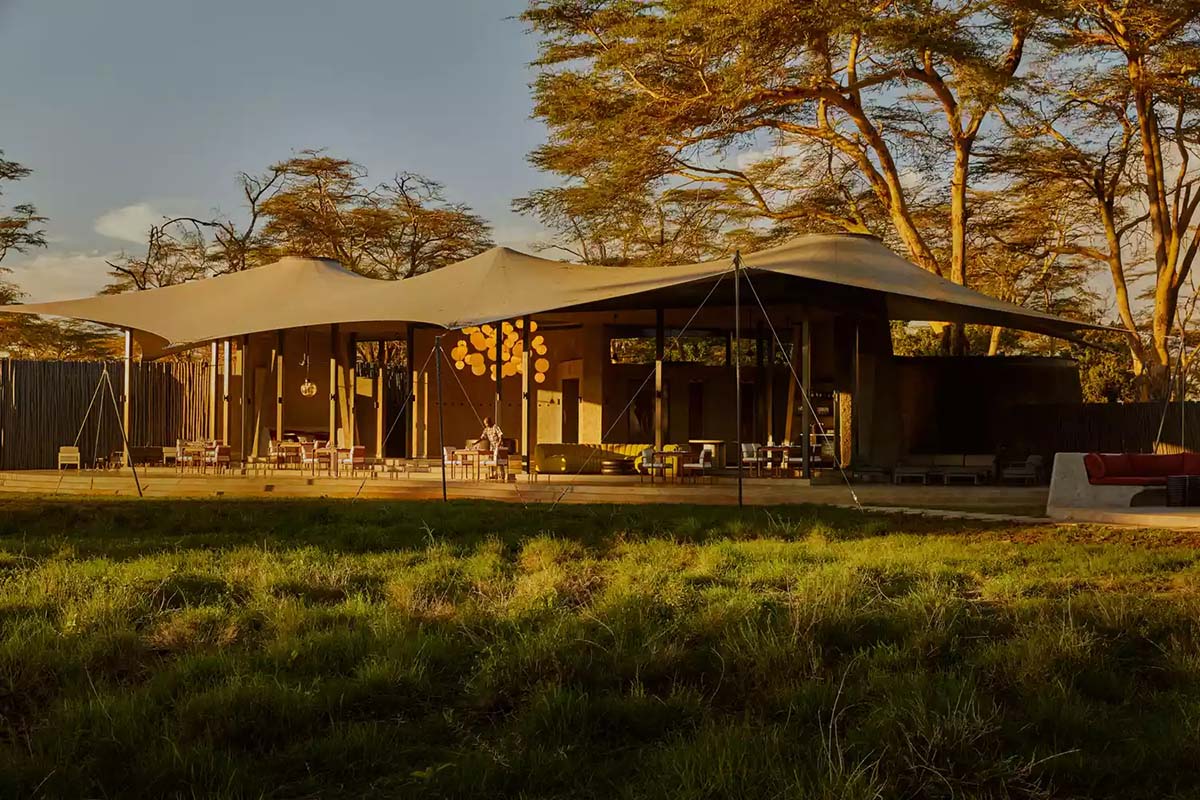 Angama Amboseli's communal guest area, where meals and drinks are served. PHOTO: EMLI BENDIXEN
“Then you look at the conservation side,” Mitchell continued. “Being here enables this place to continue to thrive as a sanctuary for elephants and other animals.”
Angama Amboseli's communal guest area, where meals and drinks are served. PHOTO: EMLI BENDIXEN
“Then you look at the conservation side,” Mitchell continued. “Being here enables this place to continue to thrive as a sanctuary for elephants and other animals.”
Eager to find out more, I met with Craig Millar, a fourth-generation Kenyan who’s now the COO of Big Life Foundation, a conservation nonprofit that helps manage more than 1.6 million acres, including the Kimana Sanctuary. I wanted his perspective on how the Angama expansion might improve things in the Amboseli-Tsavo-Kilimanjaro ecosystem and, in particular, how it could help reduce human-animal conflict — a phrase used to describe everything from crop-raiding by elephants to illegal agriculture that encroaches on land reserved for megafauna.
“On safari, you think you’re living in a bubble,” Millar told me over a spread of farm-to-table salads at Angama Amboseli including fattoush and green beans with buttermilk ranch that could have been airmailed from a Sonoma County bistro. “But you’re not. People think, ‘It’s a lovely little spot here in the wilderness,’ and that’s no longer the case.”
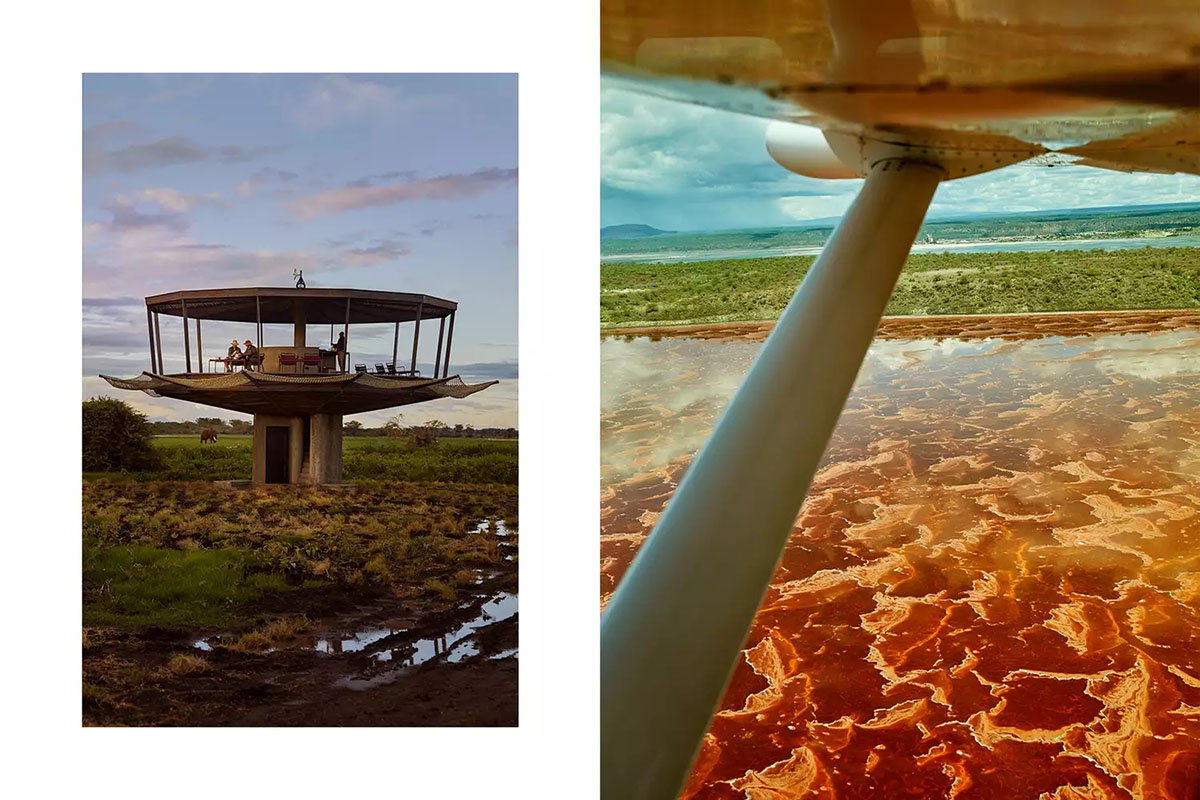 From left: The mnara, or observation tower, at Angama Amboseli; flying over the saline waters of Lake Magadi en route to Angama Mara. PHOTO: EMLI BENDIXEN
From left: The mnara, or observation tower, at Angama Amboseli; flying over the saline waters of Lake Magadi en route to Angama Mara. PHOTO: EMLI BENDIXEN
While we lunched, Millar expounded on how this stretch of southern Kenya is, for all its charismatic creatures, a place where everyday folks, many of them herders and farmers, are trying to live their lives. In an environment where an elephant might trample your crops the night before market day, the question becomes how best to create a sustainable economy that honors the needs of both people and wildlife.
For Millar, luxury tourism is one answer. “In order to make it sustainable, we needed a really high-end facility,” he said. In the past, he continued, the Kimana Sanctuary was home to mid-tier lodges with less ambitious conservation mindsets. That changed when Angama came knocking. “The company said, ‘Please tell us what you need for this place to be conserved for the next twenty years.’ ”
The result of the collaboration between Big Life and Angama is both a marvel of conscientious architecture and a five-star resort that often feels like a private camp. Angama Amboseli is arranged along an axis, radiating outward from a central guest area that’s home to the kitchen, the indoor-outdoor dining pavilion, a firepit, and a well-stocked bar. Nearby, there’s a small infinity pool as well as a watering trough that sometimes lures elephants, as well as a photo studio and a shop selling baskets, jewelry, and clothing from Nairobi-based designers.
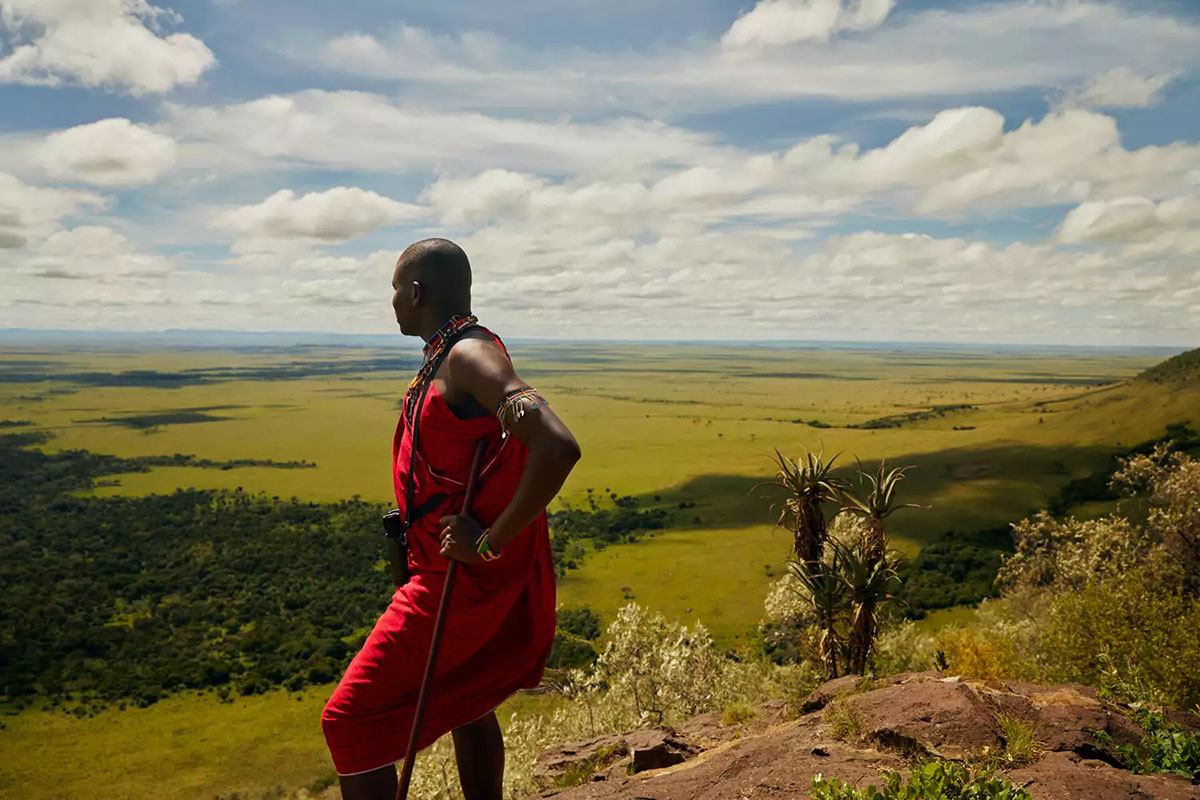 Patrick Kisiara, a Maasai guide at Angama Mara. PHOTO: EMLI BENDIXEN
Patrick Kisiara, a Maasai guide at Angama Mara. PHOTO: EMLI BENDIXEN
Then there are the guest suites, each with a king-size bed with a view of Kilimanjaro — not to mention elephants, giraffes, baboons, and whatever else might wander by. Off the bedroom is a spacious dressing area that carries through to an enormous double-vanity bathroom. Small touches, like a fresh lemon on the drinks cabinet for garnishing cocktails, or the selection of prestamped postcards at the writing desk, speak volumes about the care that’s gone into the design: intentional, without feeling fussy.
Yet for all the well-considered details at Angama Amboseli, my favorite moments were more elemental: the ocher mud flecks kicked up while walking from my suite to the guest area, the sun-bleached bones of a wildebeest, and the lilac-colored mushrooms sprouting from a mound of elephant dung. “Ellies love tomatoes,” Salaash whispered on one of our game drives, noting that he often finds solitary vines here and there around the sanctuary, grown from seeds deposited by animals that sneaked into a farmer’s plot.
Though we were often hushed during our drives, our surroundings were never silent. The place buzzed with chirps and cries and calls and howls. I felt blissfully disconnected — even though the camp has Wi-Fi and cell service. It was hard to care about my phone when climbing the mnara, an observation tower northwest of the guest area, from which I spotted elephants one evening while sipping a gin and tonic and munching on house-cured biltong. Checking the weather forecast was pointless: rain could appear — or disappear — at any moment. The peak of Kilimanjaro, hidden in the clouds for a full day, to the disappointment of both guests and staff, suddenly appeared while Millar and I were having lunch. We all dashed for our cameras when the snowcapped summit finally emerged.
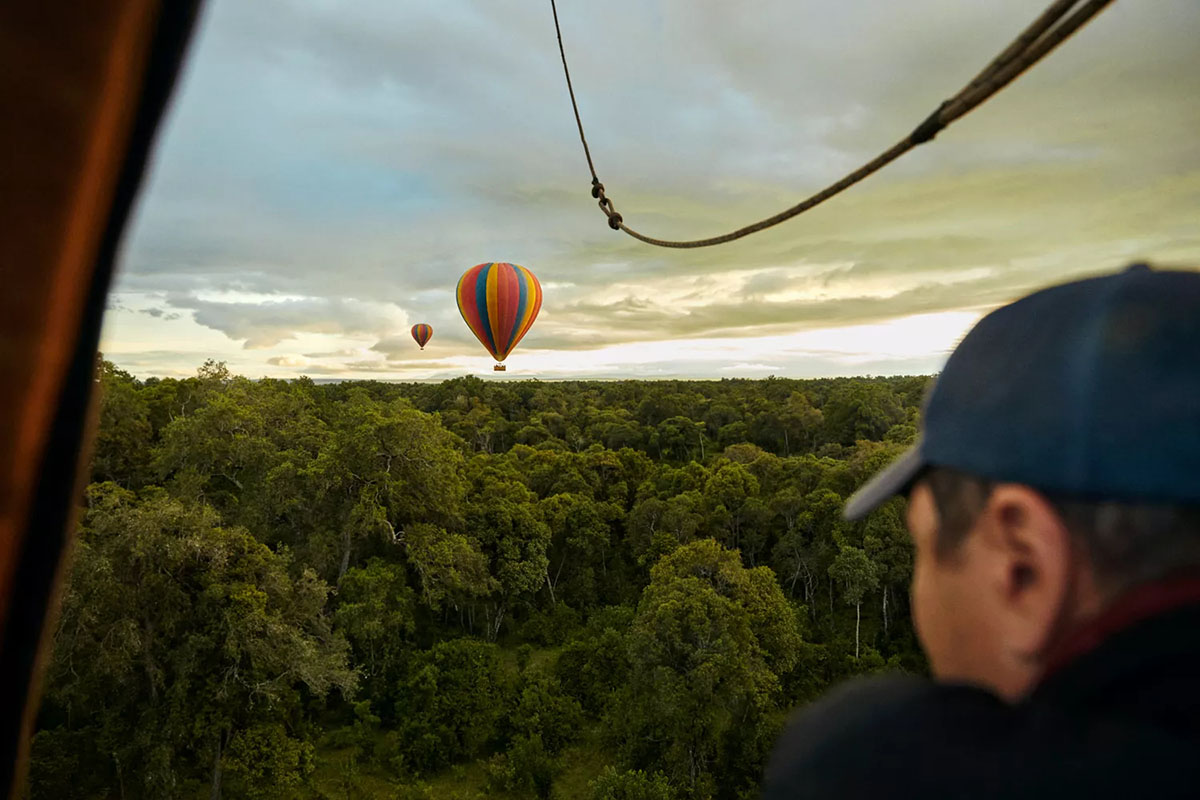 The author on a hot-air balloon ride over the Mara River. PHOTO: EMLI BENDIXEN
The author on a hot-air balloon ride over the Mara River. PHOTO: EMLI BENDIXEN
For all the spectacle in the Kimana Sanctuary surrounding the lodge, I found Amboseli National Park, about 45 minutes away, to be the most riveting corner of the ecosystem. Known among wildlife lovers as one of the best elephant-spotting destinations, the park is home to many other must-see species — lions, cheetahs, hyenas, giraffes, zebras — along with the flamingos, storks, spoonbills, and other flamboyant waders that stride through the marshes in seemingly limitless numbers.
Unlike the Serengeti or the Mara, Amboseli is for much of the year an arid, dusty place. But it springs back to life during the “short rains” that fall in November and December, when thousands of elephants congregate in its marshes to drink, feed, and cool off. We arrived early one morning and within minutes of entering the park came across a herd of 20 elephants meandering across the road without a care in the world.
 A giraffe catches the post-storm sun in the Kimana Sanctuary, near Angama Amboseli. PHOTO: EMLI BENDIXEN
A giraffe catches the post-storm sun in the Kimana Sanctuary, near Angama Amboseli. PHOTO: EMLI BENDIXEN
We pressed on, driving through swamps where countless more animals had sunk up to their bellies in the mud as they yanked up vegetation with their trunks. We passed shallow lakes brimming with birds, stopping every now and then for photographs. In the far north we came to the driest reaches of the park, which look like something from a spaghetti western, with rust-colored earth stretching to the horizon. Salaash spotted two cheetahs slinking across the plain. We tracked them for a time, hoping to witness a kill, but surrendered to our own hunger for lunch when the big cats flopped in the shade of a fallen tree trunk, content to lie in wait.
Despite its fabulous density of wildlife, Amboseli faces threats. Kenya’s government, which officially declared it a national park in 1974, plans to “degazette” Amboseli, downgrading it to a national preserve. Such a move would almost certainly reduce the park’s operating costs, but would also increase the risk of environmental degradation, according to Nancy Ogonje, the executive director of the East African Wild Life Society. “Amboseli isn’t just a park, but a symbol of our nation’s commitment to the future,” she wrote in a recent dispatch to supporters.
My final day at Angama Amboseli was cloudless, and the summit of Mount Kilimanjaro was in full view. Bendixen and I rendezvoused with Salaash for one last drive around the sanctuary. That morning, before sunrise, he’d finally spotted Craig — and was in a hurry to bundle us into a Land Cruiser, get back out there, and try to find him again.
Minutes later, we emerged from a thicket of trees and saw the elephant, along with several other bulls, munching their way through the brush. There he was. Craig’s gargantuan tusks swooped low, and his hide seemed to glow with a rich reddish dust that set him apart from the other males trooping nearby. I hurried to take dozens of photos, of course, but then, as the elephants paraded in front of the mountain, I sat back and simply drank in the scene.
 A male lion sighted near Angama Mara. PHOTO: EMLI BENDIXEN
A male lion sighted near Angama Mara. PHOTO: EMLI BENDIXEN
Craig snapped up a branch here and there, slowly approaching us. He flapped his gigantic ears. He tore a limb from an acacia tree with his trunk as though it was a tiny twig. Every so often, Salaash would reposition our Land Cruiser to keep pace with the herd.
After watching in silence for a while — snacking on the fresh rosemary biscuits Salaash had brought along — we remembered I had a plane to catch.
Back at camp, I ran into Nato, the host, who was thrilled to hear I’d finally spotted the legendary super tusker after days of searching. “You went looking for Craig, but then he came to find you,” he said. Turns out I was an elephant guy all along.
How to Do Kenya the Angama Way
A circuit of Angama’s two lodges and mobile tented camp can be done in about a week. My recommendation is to start at Angama Amboseli, which is situated about three hours’ drive southeast of Nairobi in the private Kimana Sanctuary. (Angama will arrange for a private transfer on smooth, paved roads.) Elephants are the star of the show there, and game drives can be scheduled around the clock. Lodge staff can also organize walking safaris, bush picnics, sundowners, massages, and other personalized experiences.
Next, consider flying privately to the Maasai Mara National Reserve. Scenic Air operates charters flown by affable pilots who will happily point out wildlife and landmarks such as the stunning Lake Natron. From the airstrip, a driver will ferry you over dirt and gravel roads to Angama Safari Camp, a mobile setup that’s often positioned right on the banks of the Mara River. The collection of four guest tents, each with an en suite bathroom and bucket-fed, solar-heated shower, was a COVID-era adaptation. Today it’s available as a full buyout ($7,295 for up to eight guests, all-inclusive) or, in high season, for individual bookings (from $2,100 per person). The camp is attended by a private staff, who cook meals over a campfire, swap stories about life in the bush, and can help chase away any errant hippos that might wander by.
From there it’s a short drive to Angama Mara, set high on a cliff with a Lion King–esque view of the plains. First opened in 2015, the 30-suite property remains one of East Africa’s most exclusive and cosseting, with game drives and walking safaris as well as a swimming pool, boutique, and photo studio. The property’s organic kitchen garden is open for tours — and for lunch, which is served on a shaded deck and is a highlight for many visitors, myself included. Angama Mara also hosts occasional programs of Maasai song and dance, with many performers drawn from the lodge’s staff.
Angama has its own full-service travel desk that can coordinate logistics, but travelers interested in an itinerary that incorporates other lodges should call on the services of the safari specialists on T+L’s A-List.
A version of this story first appeared in the April 2024 issue of Travel + Leisure under the headline "High and Mighty."
Original article
